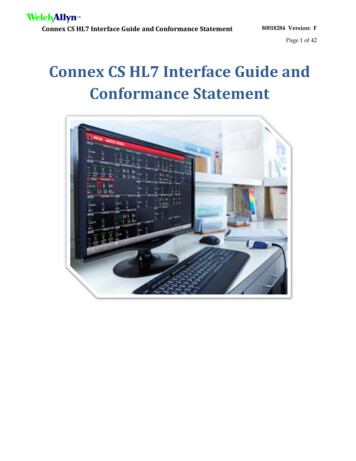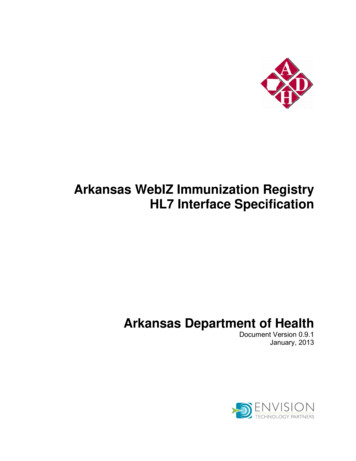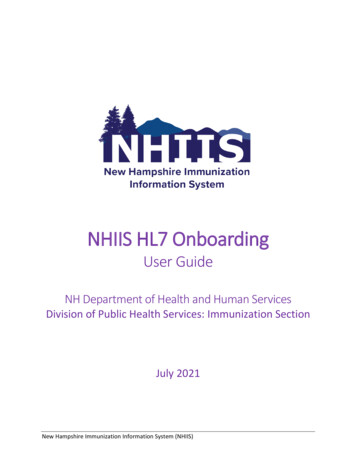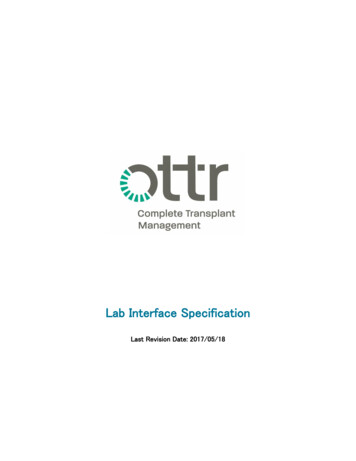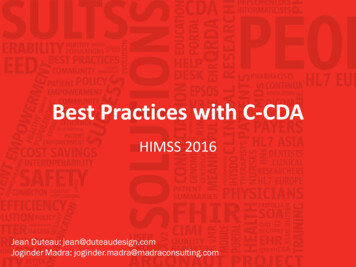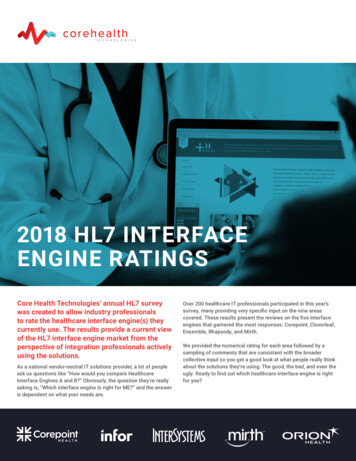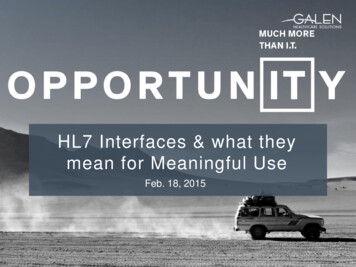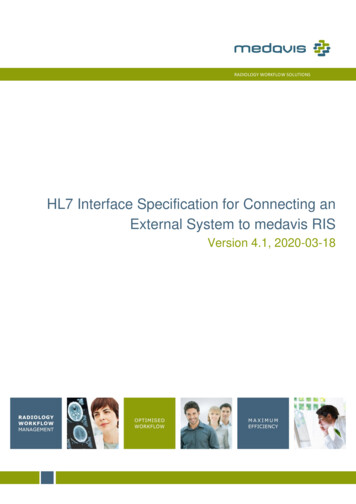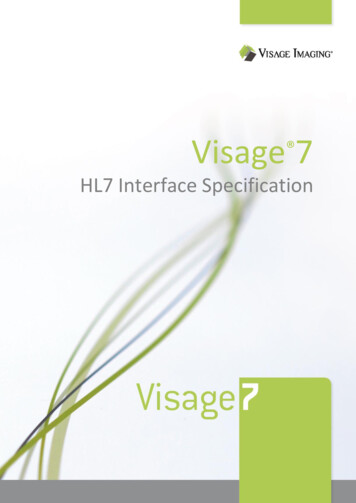
Transcription
Visage 7 HL7 Interface Specification
Information about manufacturer and distribution contacts as well as regulatorystatus of the product can be found in the User Manual.Some of the specifications described herein may not be currently available in allcountries. Please contact your local sales representative for the most currentinformation.Visage Imaging is a trademark and/or service mark of ProMedicus. All otherproducts mentioned may be trademarks or registered trademarks of theirrespective holders.Visage Imaging believes this information is accurate as of its publication date andis not responsible for any inadvertent errors. The information contained herein issubject to change without notice.Copyright Visage Imaging GmbH. All rights reserved.Document Version 21.00 – Jun 2019
Visage 7 – HL7 Interface SpecificationTable of Contents1.Introduction. 51.1 Audience. 51.2 Remarks . 51.3 Abbreviations and Acronyms . 52.Functional Overview. 72.1 General . 72.1.1 Patient information reconciliation . 72.1.2 Quality assurance . 72.1.3 Prefetching . 72.1.4 Incoming reports . 82.1.5 Handling of unsupported messages . 82.2 Framework . 93.Communication Interface. 104.Message Description . 114.1 Overview . 114.1.1 Supported IHE Profile . 114.1.2 Supported HL7 Versions . 114.1.3 Supported Message Types . 114.1.4 MSH Segment . 124.2 ADT Messages . 134.2.1 ADT A01 - Admin/Visit Patient . 134.2.2 ADT A02 - Patient Transfer . 154.2.3 ADT A03 - Patient Discharge . 174.2.4 ADT A04 – Register a Patient . 184.2.5 ADT A05 – Pre-Admit a Patient . 194.2.6 ADT A06 – Change an Outpatient to an Inpatient. 214.2.7 ADT A07 – Change an Inpatient to an Outpatient. 224.2.8 ADT A08 - Update Patient Information . 234.2.9 ADT A11 – Cancel Admit / Visit Notification . 244.2.10 ADT A12 – Cancel Transfer . 254.2.11 ADT A13 – Cancel Discharge / End Visit . 264.2.12 ADT A18 - Merge Patient Information . 274.2.13 ADT A28 – Add Person or Patient Information . 294.2.14 ADT A31 - Update Person Information . 304.2.15 ADT A38 – Cancel Pre-Admit . 31Copyright Visage Imaging GmbH3 / 61V21.00 – Jun 2019
Visage 7 – HL7 Interface Specification4.2.16 ADT A40 - Merge Patient (Patient Identifier List) . 324.2.17 ADT A41 - Merge Account - Patient Account Number . 344.2.18 ADT A45 - Move Visit Information - Visit Number . 364.3 OMG Messages . 384.3.1 OMG O19 – Placer Order Management . 384.4 ORM Messages . 404.4.1 ORM O01 – Procedure Scheduled/Updated . 404.5 ORU Messages . 434.5.1 ORU R01 – Observational report – unsolicited . 434.6 SIU Messages. 474.6.1 SIU S12 – New Appointment Booking . 474.7 Acknowledge Messages . 494.7.1 Message Contents . 494.7.2 Message Status. 494.7.3 Example Message . 504.8 Attribute Mapping . 514.8.1 Patient Information Reconciliation . 514.8.2 Scheduling/Updating Procedures. 544.8.3 Configuration. 564.9 Outgoing HL7 Messages . 584.9.1 Study Completed: Message Specification . 585.Document History . 61Copyright Visage Imaging GmbH4 / 61V21.00 – Jun 2019
Visage 7 – HL7 Interface Specification1. Introduction1.1 AudienceThis document is intended for hospital staff, health system integrators, software designers orimplementers. It is assumed that the reader has a working understanding of HL7.1.2 RemarksThis document is the HL7 Interface Specification for Visage 7.HL7, by itself, does not guarantee interoperability. However, the Interface Specificationfacilitates a first-level validation for interoperability between different applications supporting thesame HL7 functionality.This Interface Specification is not intended to replace validation with other HL7 equipment toensure proper exchange of information intended.The scope of this Interface Specification is to facilitate communication between Visage 7 andother HL7 systems. The Interface Specification should be read and understood in conjunctionwith the HL7 Standard and the IHE Technical Framework Revision 7.0. However, by itself it isnot guaranteed to ensure the desired interoperability and a successful interconnectivity.The user should be aware of the following important issues: The comparison of different Interface Specifications is the first step towards assessinginterconnectivity between Visage 7 and other HL7 conformant equipment. Test procedures should be defined to validate the desired level of connectivity.1.3 Abbreviations and GORMORUPACSAcknowledgeAdmission, Discharge and TransferClient/ServerDigital Imaging and Communications in MedicineDepartment System SchedulerHealth Level 7Integrating the Healthcare EnterpriseInternet ProtocolMinimal Lower Layer ProtocolMessage Acknowledgement (Segment)Merge Patient Information (Segment)Message Header (Segment)Lower Layer ProtocolGeneral Clinical Order MessageGeneral Order MessageObservational Report UnsolicitedPicture Archiving and Communication SystemCopyright Visage Imaging GmbH5 / 61V21.00 – Jun 2019
Visage 7 – HL7 Interface SpecificationPIDPIRPV1RISSIUTCPUIDUTFVRPatient Identification (Segment)Patient Information ReconciliationPatient Visit (Segment)Radiology Information SystemSchedule Information UnsolicitedTransmission Control ProtocolUnique IdentifierUnicode Transformation FormatValue RepresentationCopyright Visage Imaging GmbH6 / 61V21.00 – Jun 2019
Visage 7 – HL7 Interface Specification2. Functional Overview2.1 General2.1.1 Patient information reconciliationThe Visage 7 concept is based on a modular architecture for distributing medical images andreports within and outside of a clinical area. It allows external systems to send DICOM objectsto it for temporary storage and long-term archiving.This requires to provide mechanisms for patient information reconciliation. Therefore Visage 7implements a HL7 Interface which supports a subset of HL7 messages defined by the IHEtransaction ‘Patient Update’.The functionality which is provided with the HL7 module is: Reception of incoming HL7 trigger event messages. Converting information received with the HL7 messages into DICOM conforming data sets. Performing patient information reconciliation processes by modifying DICOM objects storedwithin Visage 7 according to the HL7 requests. Triggering prefetching of prior studies from a remote DICOM archive upon receipt of order orappointment messages. Sending appropriate response messages to the sender of the request message.In addition Visage can be configured to send out HL7 messages to a HL7 partner node(typically a RIS system) in order to indicate that a certain study is considered complete (allimages received) or verified (QA status completed).2.1.2 Quality assuranceAdditionally, Visage 7 implements functionality for quality assurance of incoming DICOMimages: the data contained in images can be matched against HL7 messages defined by theIHE transaction ‘Procedure Scheduled’ / ‘Procedure Updated’. In case differences are identified,those can be automatically corrected in the images, or they can be manually checked using theQuality Assistance function in the Visage Client.The functionality which is provided by the HL7 module for this is: Reception of incoming HL7 order event messages. Converting these messages and storing them locally in a data base. Sending appropriate response messages to the sender of the request message. Match procedures against images and perform the required updates in the images, ifconfigured.2.1.3 PrefetchingPrefetching of DICOM objects denotes the operation to retrieve, from an external DICOM nodesuch as an archive, DICOM objects that are needed at the time of a new examination. Typicallyprior DICOM studies that may be needed for comparison purposes are prefetched. Visage 7supports to do prefetching based on HL7 messages, for example when the message of a newCopyright Visage Imaging GmbH7 / 61V21.00 – Jun 2019
Visage 7 – HL7 Interface Specificationappointment has been received. Prefetching can be also done based of HL7 order eventmessages.The functionality which is provided by the HL7 module for this is: Reception of incoming HL7 messages. Converting the data to update the prefetching queue in the Visage 7 data base. Forprefetching, HL7 messages are not separately stored in the database. Sending appropriate response messages to the sender of the request message. The prefetching queue is processed asynchronously by a separate service.2.1.4 Incoming reportsVisage 7 can accept, store, register and display text reports that match specific studies. Thereports functionality of the HL7 module includes: Reception of incoming HL7 ORU R01 messages containing reports (text lines)Storing and registering reports in the Visage 7 database.Matching reports to existing studies.Matching incoming studies to existing reportsSending appropriate response messages to the sender of the request message.Visage 7 GUI access to reports2.1.5 Handling of unsupported messagesAdditionally, the HL7 can report to the sender about unsupported messages (unsupportedmessage types or HL7 versions).Copyright Visage Imaging GmbH8 / 61V21.00 – Jun 2019
Visage 7 – HL7 Interface Specification2.2 FrameworkThe HL7 communication takes place between the ADT actor and Visage 7 which works as theImages Manager / Image Archive actor according to the IHE Standard. For specific integrationscenarios, Visage 7 can be optionally configured to provide a subset of the Department SystemScheduler / Order Filler functionality. Actors are communication systems or components ofinformation systems that produce, manage or act on information associated with operationalactivities in the enterprise. In the following the actors are described that are affected by theVisage 7 HL7 communication: ADT System:A system responsible for adding and/or updating patient demographic and encounterinformation. Department System Scheduler / Order Filler:A system that provides functions related to the management of orders received from externalsystems or through the departments system’s user interface. Image Manager:A system that provides functions related to safe storage and management of evidenceobjects. Image Archive:A system that provides long term storage of evidence objects.In the following diagram the data flow between the actors ADT and DSS / Order Filler and theImage Manager / Image Archive that is represented by Visage 7 is illustrated.ACKSIU S12New Appointment BookingORM O01Procedure Scheduled/UpdatedADT A40Patient MergeADT A31Update Person InformationADT A08Update Patient InformationADT A03Patient DischargeADT A02Patient TransferACKDSS / OrderFiller System(RIS)ADT System(HIS)Image Manager / Image Archive(Visage PACS/CS)Copyright Visage Imaging GmbH9 / 61V21.00 – Jun 2019
Visage 7 – HL7 Interface Specification3. Communication InterfaceThe HL7 Standard recommends the Minimal Lower Layer Protocol (MLLP) for thecommunication between HL7 systems. For this purpose the HL7 Interface of Visage 7 providesa unidirectional TCP/IP socket interface. The Lower Layer Protocol defined by the HL7Standard is implemented as follows: Message Start Character:0x0B Segment End Character:0x0D Message Stop Characters:0x1C and 0x0D Character Encoding:UTF-8Visage 7 allows to configure the character encoding of HL7 messages to UTF-8, Ansi (codepage 1252), Mac (code page 10000), and default (standard Microsoft Windows encoding). Theother parameters are not configurable within the Visage 7 implementation. The number ofconcurrent connections which can be handled by Visage 7 is not limited.Copyright Visage Imaging GmbH10 / 61V21.00 – Jun 2019
Visage 7 – HL7 Interface Specification4. Message Description4.1 OverviewVisage 7 is able to handle a subset of ADT messages which are used to transmit portions of thePatient Administration data from one system to another. Additionally received ORM messagesare accepted and responded to satisfy the requirements of the IHE Scheduled Workflow Profile.It also handles ORU messages containing reports as per IHE Simple Image and NumericReport Profile.This chapter informs about the supported HL7 versions and message types and describes theexpected message contents and in which way the received data is used for further processing.4.1.1 Supported IHE ProfileThe Visage 7 HL7 interface supports a subset of HL7 messages defined by following IHEprofiles and transactions: Scheduled Workflow (SWF)Procedure ScheduledProcedure UpdatedPlacer Order Management(optional, only if explicitly configured) Patient Information Reconciliation (PIR)Patient Update Simple Image and Numeric Report (SINR)Structured Report Export4.1.2 Supported HL7 VersionsThe Visage 7 HL7 interface supports messages which are conform to the subset of HL7versions which is listed below. Visage 7 responds to received messages of a not supportedversion with an Application Reject Acknowledgement message (see 4.7). HL7 Version 2.2 HL7 Version 2.3 HL7 Version 2.3.1 HL7 Version 2.4 HL7 Version 2.5 HL7 Version 2.5.14.1.3 Supported Message TypesThe Visage 7 HL7 interface supports the reception of the subset of ADT, ORM, ORU and SIUmessage types which is listed below. Visage 7 responds to received messages of a notsupported type with an Application Reject Acknowledgement message (see 4.7).Copyright Visage Imaging GmbH11 / 61V21.00 – Jun 2019
Visage 7 – HL7 Interface Specification ADT A01 (Admin/Visit Patient) ADT A02 (Transfer a Patient) ADT A03 (Discharge/End Visit) ADT A04 (Register a Patient) ADT A05 (Pre-Admit a Patient) ADT A06 (Change an Outpatient to an Inpatient) ADT A07 (Change an Inpatient to an Outpatient) ADT A08 (Update Patient Information) ADT A11 (Cancel Admin / Visit Notification) ADT A12 (Cancel Transfer) ADT A13 (Cancel Discharge / End Visit) ADT A18 (Merge Patient Information) ADT A28 (Add Person or Patient Information) ADT A31 (Update Person Information) ADT A38 (Cancel Pre-Admit) ADT A40 (Merge Patient – Patient Identifier List) ADT A41 (Merge Account – Patient Account Number) ADT A45 (Move Visit Information – Visit Number) OMG O19 (Placer Order Management) ORM O01 (Procedure Scheduled/Updated) ORU R01 (Observational report – unsolicited) OMI O23 SIU S12 (New Appointment Booking)4.1.4 MSH SegmentAll incoming HL7 messages must have an MSH segment with the following components. Thelast column of the table specifies the expected values and their intended use.MSH SegmentSEQComponent NameDTOPT1Field SeparatorSTRFor this element ‘ ’ is expected.2Encoding CharactersSTRFor this element ‘ \&’ is expected.3Sending ApplicationHDOUsed to fill the Receiving Application in theacknowledgement message.4Sending FacilityHDOUsed to fill the Receiving Facility in theacknowledgement message.7Date/Time of MessageTSOCurrent date and time when the messagewas created.9Message TypeCMRE.g., ‘ADT A01’ (controls the message type).10Message Control IDSTRUsed to fill the acknowledge message.11Processing IDPTRUsed to fill the acknowledge message.12Version IDVITRUsed for HL7 version check and to fill theacknowledge message.Value* R required; O optional; DT Date TypeCopyright Visage Imaging GmbH12 / 61V21.00 – Jun 2019
Visage 7 – HL7 Interface Specification4.2 ADT Messages4.2.1 ADT A01 - Admin/Visit PatientAn A01 event signals the result of a patient undergoing the admission process which hasassigned the patient to a bed. This message type is used to store and update demographic andpatient location information of the patient. Processing this message type is not part of the IHEScheduled Workflow profile (SWF). Therefore processing of the message type is disabled bydefault.4.2.1.1 Message SpecificationThe Admin/Visit Patient request and acknowledgement is specified by following trigger eventand message types:Trigger Event:Type of Request Message:Message Structure:Type of Acknowledge Message:A01ADT A01ADT A01 (determined automatically if omitted)ACK A014.2.1.2 Segment DescriptionThe message segments and elements in the following tables are necessary to perform thepatient update process and to generate an appropriate acknowledge message. The last columnof the tables specifies the expected values and their intended use.PID SegmentSEQComponent NameDTOPT Value3Patient Identifier ListCXRUsed to identify the patient for the updateprocess. See section 4.8.1.1.4Patient NameXPNRNew name for the specified patient. Seesection 4.8.1.2.7Date/Time Of BirthTSRNew date/time of birth for the specifiedpatient.8SexISRNew sex for the specified patient.*R required; *O optional; *DT Date TypePV1 SegmentSEQ3Component NameAssigned Patient LocationDTPLOPT ValueONew assigned location for the specifiedpatient.*R required; *O optional; *DT Date TypeCopyright Visage Imaging GmbH13 / 61V21.00 – Jun 2019
Visage 7 – HL7 Interface SpecificationConstraints: A PIR process can only be performed for patients with a valid Patient ID. If the Visage 7 DICOM database contains two or more patients with identical Patient IDs, thePIR process is performed for all of them. Visage 7 cannot perform a PIR process if it results in two or more identical patients. For PIR jobs no retry and visualization mechanisms are provided. When a PIR process is performed HTML reports stored in Visage 7 are either deleted or awarning text is added to the document depending on the configuration settings.4.2.1.3 Attribute ProcessingThe reception of an ADT A01 message results in a PIR process in order to update patientinformation. Therefore it is necessary to convert the HL7 elements contained in the requestmessage into appropriate DICOM attributes. This mapping process is described in chapter4.8.1.4.2.1.4 AcknowledgementVisage 7 sends the acknowledge message after the PIR job was initiated or it is certain that PIRprocessing could not be performed successfully. In case of an unrecognized patient specified bythe ‘Patient Identifier List’ item Visage 7 ignores the request and responds with status ‘Success’.See chapter 4.7 for a detailed acknowledge message description.4.2.1.5 Example MessageMSH \& SendingApp SendingFac 20150326100000 ADT A01 MSGID 1011 P 2.3EVN A01 20150326100000PID PID 001 Doe John 19620326 M PV1 I R 220 B 2155 Copyright Visage Imaging GmbH14 / 61V21.00 – Jun 2019
Visage 7 – HL7 Interface Specification4.2.2 ADT A02 - Patient TransferThis message type is used to update the location of a specific patient.4.2.2.1 Message SpecificationThe Patient Transfer request and acknowledgement is specified by following trigger event andmessage types:Trigger Event:Type of Request Message:Message StructureType of Acknowledge Message:A02ADT A02ADT A02 (determined automatically if omitted)ACK A024.2.2.2 Segment DescriptionThe message segments and elements in the following tables are necessary to perform thepatient visit update process and to generate an appropriate acknowledge message. The lastcolumn of the tables specifies the expected values and their intended use.PID SegmentSEQComponent Name6Patient Identifier ListDTCXOPT ValueRUsed to identify the patient for the updateprocess. See Section 4.8.1.1.*R required; *O optional; *DT Date TypePV1 SegmentSEQComponent Name3Assigned Patient LocationDTPLOPT ValueONew assigned location for the specifiedpatient.*R required; *O optional; *DT Date TypeConstraints: A PIR process can only be performed for patients with a valid Patient ID. If the Visage 7 DICOM database contains two or more patients with identical Patient IDs, thePIR process is performed for all of them. For PIR jobs no retry and visualization mechanisms are provided. When a PIR process is performed HTML reports stored in Visage 7 are either deleted or awarning text is added to the document depending on the configuration settings.Copyright Visage Imaging GmbH15 / 61V21.00 – Jun 2019
Visage 7 – HL7 Interface Specification4.2.2.3 Attribute ProcessingThe reception of an ADT A02 message results in a PIR process in order to update patient visitinformation. Therefore it is necessary to convert the HL7 elements contained in the requestmessage into appropriate DICOM attributes. This mapping process is described in chapter4.8.1.4.2.2.4 AcknowledgementVisage 7 sends the acknowledge message after the PIR job was initiated or it is certain that PIRprocessing could not be performed successfully. In case of an unrecognized patient specified bythe ‘Patient Identifier List’ item Visage 7 ignores the request and responds with status ‘Success’.See chapter 4.7 for a detailed acknowledge message description.4.2.2.5 Example MessageMSH \& SendingApp SendingFac 20150326100000 ADT A02 MSGID 1021 P 2.3EVN A02 20150326100000PID PID 001 Doe John 19620326 M PV1 I R 320 B 3155 Copyright Visage Imaging GmbH16 / 61V21.00 – Jun 2019
Visage 7 – HL7 Interface Specification4.2.3 ADT A03 - Patient DischargeThis message type is used to signal the end of a patient’s stay in a healthcare facility byupdating the location of a specific patient.4.2.3.1 Message SpecificationThe Patient Discharge request and acknowledgement is specified by following trigger event andmessage types:Trigger Event:Type of Request Message:Message StructureType of Acknowledge Message:A03ADT A03ADT A03 (determined automatically if omitted)ACK A034.2.3.2 DescriptionProcessing and acknowledgement of an ADT A03 message is the same as for an ADT A02message. See sections 4.2.2.2 to 4.2.2.4 for details.4.2.3.3 Example MessageMSH \& SendingApp SendingFac 20150326100000 ADT A03 MSGID 1031 P 2.3EVN A03 20150326100000PID PID 001 Doe John 19620326 M PV1 O Copyright Visage Imaging GmbH17 / 61V21.00 – Jun 2019
Visage 7 – HL7 Interface Specification4.2.4 ADT A04 – Register a PatientThis message type signals that the patient has arrived or checked in. It is used to store andupdate demographic and patient location information of the patient. Processing this messagetype is not part of the IHE Scheduled Workflow profile (SWF). Therefore processing of themessage type is disabled by default.4.2.4.1 Message SpecificationThe Register a Patient request and acknowledgement is specified by following trigger event andmessage types:Trigger Event:Type of Request Message:Message Structure:Type of Acknowledge Message:A04ADT A04ADT A01 (determined automatically if omitted)ACK A044.2.4.2 DescriptionProcessing and acknowledgement of an ADT A04 message is the same as for an ADT A01message. See sections 4.2.1.2 to 4.2.1.4 for details.4.2.4.3 Example MessageMSH \& SendingApp SendingFac 20150326100000 ADT A04 MSGID 1041 P 2.3EVN A04 20150326100000PID PID 001 Doe John 19620326 M PV1 I R 110 B 1155 Copyright Visage Imaging GmbH18 / 61V21.00 – Jun 2019
Visage 7 – HL7 Interface Specification4.2.5 ADT A05 – Pre-Admit a PatientAn A05 event signals that a patient has undergone the pre-admission process. It causes thatdemographics of a specific patient are stored or updated. Processing this message type is notpart of the IHE Scheduled Workflow profile (SWF). Therefore processing of the message type isdisabled by default.4.2.5.1 Message SpecificationThe Pre-Admit a Patient request and acknowledgement is specified by following trigger eventand message types:Trigger Event:Type of Request Message:Message Structure:Type of Acknowledge Message:A05ADT A05ADT A05 (determined automatically if omitted)ACK A054.2.5.2 Segment DescriptionThe message segments and elements in the following tables are necessary to perform thepatient update process and to generate an appropriate acknowledge message. The last columnof the table specifies the expected values and their intended use.PID SegmentSEQComponent NameDTOPT Value3Patient Identifier ListCXRUsed to identify the patient for the updateprocess. See section 4.8.1.1.4Patient NameXPNRNew name for the specified patient. Seesection 4.8.1.2.7Date/Time Of BirthTSRNew date/time of birth for the specifiedpatient.8SexISRNew sex for the specified patient.*R required; *O optional; *DT Date TypeNote:The difference for Visage 7 when processing ADT A01 or ADT A05 message is the following:With an ADT A01 message, both patient demographics and patient location are updated. Withan ADT A05 message, only the patient demographics are updated. Any information in the PV1segment of an ADT A05 message is ignored.Constraints: A PIR process can only be performed for patients with a valid Patient ID. If the Visage 7 DICOM database contains two or more patients with identical Patient IDs, thePIR process is performed for a
The scope of this Interface Specification is to facilitate communication between Visage 7 and other HL7 systems. The Interface Specification should be read and understood in conjunction with the HL7 Standard and the IHE Technical Framework Revision 7.0. However, by itself it is not guaranteed to ensure the desired interoperability and a .

